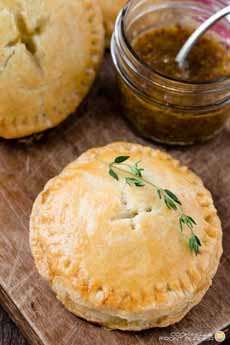FOOD FUN: Hand Pies Grow Up
|
|
Like pie? Like savory pie? Like fancy desserts? Combine the two with plated hand pies. The pies, meant to be eaten without plate or fork, taste even better with a bit of glamour. Sweet Hand Pies Restaurant Sirena Cocina Latina in San Diego plated fruit pies with dessert garnishes (photo #1): For an appetizer or first course, you can make meat, cheese or vegetable hand pies—or any variation combination (photo #3). Choose savory garnishes: Since there was dough, something to fill it with, and something to bake it on or in, there have been hand pies—beginning with savory pies. Cultures around the world have what we now call hand pies: portable meals that could be stuffed with leftovers or any variety of kitchen ingredients. Empanadas, a popular Mexican street food, Jewish knishes and and Jamaican meat patties are hand pies. Until someone in the U.S. called them hand pies (if you know who, raise your hand), these grab-and-go mini-meals were called meat pies or pasties (rhymes with nasty, not tasty). In our own culture, they trace their origins at least to 19th-century England, where they were a convenient lunch for Cornish tin miners—but not as we eat pasties today. For miners, the pastry casing kept the filling warm and dirt-free. Holding the edges, miners would eat the filling and discard the dough. Cornish immigrants to northern Michigan brought the tradition to the U.S. [source] The concept engendered fruit versions among America’s home pie bakers, and corner sweet shops sold them to enthusiastic fans. |
|
|
Sweet hand pies traveled south, where they became popular in New Orleans (Hubig’s bakery made theirs in a half-moon shape, with fruit, custard and chocolate fillings). Hand pies became a Southern snack staple, made for church bake sales, picnics and home treats. They’re portable, requiring no plate or fork, and can sit in the heat without melting. Give us a good crust, and we’re in! |
||





